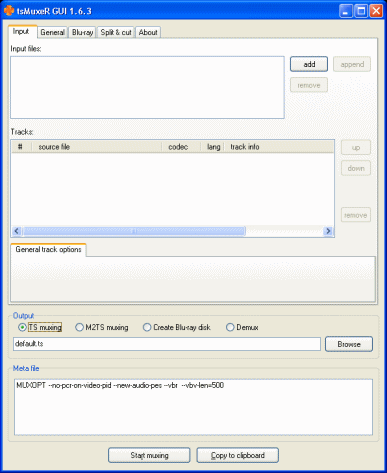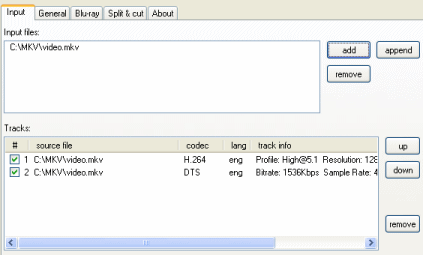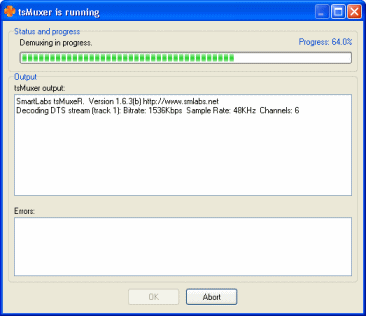Extract AC3 or DTS audio from MKV files
 This articles shows a very quick process to demux audio streams from MKV (matroska) multimedia files using the SmartLabs tsMuxer software. You can also use this article to demux video streams from MKV, or any streams that tsMuxer will support.
This articles shows a very quick process to demux audio streams from MKV (matroska) multimedia files using the SmartLabs tsMuxer software. You can also use this article to demux video streams from MKV, or any streams that tsMuxer will support.Introduction & Requirements
Download SmartLabs tsMuxer --> Download tsMuxer and use WinRAR to extract the contents of the download into any folder that you wish.
tsMuxer supports opening MKV files directly and can be used to either create transport stream files, M2TS files, AVCHD or to demux individual streams.
Open tsMuxer
 After you have extracted all the files from WinRAR to a folder, run the TsMuxerGUI.exe file. This program is not very complicated at all but what it achieves is ground breaking for PS3 & Blu-ray video.
After you have extracted all the files from WinRAR to a folder, run the TsMuxerGUI.exe file. This program is not very complicated at all but what it achieves is ground breaking for PS3 & Blu-ray video.
Make sure you are in the Input tab. Look at the blank Input files field, click the Add button beside this.
Open MKV file
 When you have clicked Add, use the file browser to locate and open the MKV file you wish to extract audio (or video and subtitles) from. You will now notice that tsMuxer will display the tracks that are stored in the MKV file that you have selected. In the sample picture to the right of this text (you can click to enlarge if you need to) you can see that my file has H.264 video and DTS audio.
When you have clicked Add, use the file browser to locate and open the MKV file you wish to extract audio (or video and subtitles) from. You will now notice that tsMuxer will display the tracks that are stored in the MKV file that you have selected. In the sample picture to the right of this text (you can click to enlarge if you need to) you can see that my file has H.264 video and DTS audio.
Technically I can extract either of these but I only want the audio.
Select track(s) to demux
 You can now select the tracks that you want to demux from the MKV file. By default, all supported tracks are selected (the tick box beside the track is ticked). Untick whatever you do not want to demux, and leave only the track(s) you want to demux selected, like shown in the sample picture.
You can now select the tracks that you want to demux from the MKV file. By default, all supported tracks are selected (the tick box beside the track is ticked). Untick whatever you do not want to demux, and leave only the track(s) you want to demux selected, like shown in the sample picture.
Now we must set tsMuxer to demux mode.
Set tsMuxer to demux
 Under the Output area of tsMuxer shown in the sample picture (click picture to enlarge to a full uncropped screenshot of tsMuxer if you are confused), select the Demux option as shown. While you are there, make sure that the folder the program is set to save in is OK (the default folder is the same folder as the original MKV file). If your audio is AC3, then tsMuxer will save a .AC3 file and likewise if it is DTS, it will save a .DTS file, or .264 for H.264 video etc. If you want to change the Output folder click Browse and do so. Otherwise, you are ready to begin.
Under the Output area of tsMuxer shown in the sample picture (click picture to enlarge to a full uncropped screenshot of tsMuxer if you are confused), select the Demux option as shown. While you are there, make sure that the folder the program is set to save in is OK (the default folder is the same folder as the original MKV file). If your audio is AC3, then tsMuxer will save a .AC3 file and likewise if it is DTS, it will save a .DTS file, or .264 for H.264 video etc. If you want to change the Output folder click Browse and do so. Otherwise, you are ready to begin.Demux stream(s) from MKV file
 When you are ready, click the Start demuxing button at the end of the tsMuxer program. A new window will now open and the process will begin. This stripping process should not take very long, but the time it takes depends entirely on the speed of your computer and the size of the MKV file you are extracting from.
When you are ready, click the Start demuxing button at the end of the tsMuxer program. A new window will now open and the process will begin. This stripping process should not take very long, but the time it takes depends entirely on the speed of your computer and the size of the MKV file you are extracting from.Finally
Hopefully this article will have shown you how to easily extract video and audio streams from MKV files using tsMuxer. If you need more assistance, please visit our Discussion Forums and ask for help.
Version History
v1.0 -- First Version Online by Dela (09/05/2008)
Written by: James Delahunty

